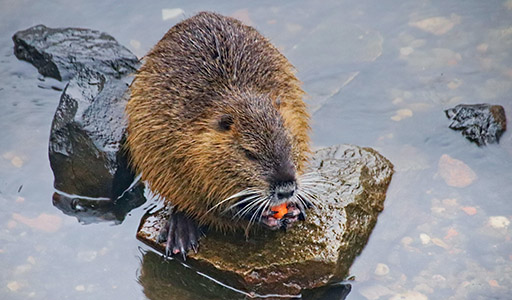Beavers

Beaver Information
North American beavers inhabit most of the United States with the exception of the warmer regions of Florida and California. Beavers can live in a variety of different environments, but are most typically found in natural or man-made wetlands such as ponds, marshes, and rivers. Once they inhabit an environment, groups of beavers construct complicated dams and lodges to create ideal living spaces for them and their families.
If you’ve noticed a beaver’s well-constructed dam or habitat on your property or are kept up at night by the nocturnal habits of these animals, it is time to call the wildlife maintenance experts at Trutech. Don’t let these creatures cause thousands of dollars in damage before you call Trutech. If you notice a problem, find a solution with Trutech’s top quality beaver control and beaver removal services.

What does a Beaver look like?
Growing up to 5 feet in length and weighing in excess of 90 pounds, beavers are much larger than other aquatic rodents found in the United States. They are brown in color and have large heads and broad, flat tails covered in black scales. Strong swimmers and diggers, beavers also possess strong back legs and webbed feet. As is the case with most rodents, their orange front incisors are always growing, which makes it necessary for beavers to regularly chew on bark or similar substances. The large aquatic rodents can close off their nostrils and ears in order to swim underwater for longer periods of time.

What does a Beaver eat?
Targeting species like maple, beech, alder, and willow, beavers feed on both the bark and cambium, or the soft wood found underneath the bark, of trees. The rodents also feed on aquatic vegetation and enjoy the leaves, roots, and tubers of growing plants. Beavers will actually store food for the winter by shoving trees and shrubs into the mud at the bottom of ponds or streams.

Beaver habits
Beavers build dens made of sticks, mud, grass, and moss. These burrows are found either in bodies of water or on banks near water. Beaver dens usually have two or more access points, with at least one located underwater. The rodents can be found throughout North America, though they typically do not live too far north or in the deserts of the Southwest United States.
Defensive Behavior
Beavers are dangerous when cornered. The animals may lunge forward to bite and defend themselves. Before an attack, the pests make hissing sounds and even sharpen their teeth. However, beavers are mean only when threatened.
Where Do Beavers Live?
At nearly three feet in length and around 50 pounds, beavers are the largest rodents in the United States. Well-known for their habit of chewing on trees, the pests often live on properties by streams or rivers. The ideal beaver habitat is also the perfect location for a dam, including of any area with flowing water surrounded by trees and vegetation.
Frequently Asked Questions
As semi-aquatic creatures, beavers are on land less often than other mammals and have fewer opportunities to leave tracks. When beaver tracks are seen, they’re usually on the muddy banks of a river. Both their front and hind feet have five toes, though their hind feet are webbed. Tracks will appear very close together on each side due to the animals’ gait. Their flat tails drag on the ground when they walk, sometimes partially wiping away tracks and obscuring them. It is rare to find beaver tracks in the snow because they prefer to spend as much time as possible in their lodges when it’s cold outside.
Though they share similar habitats, distinguishing between beavers vs. otters is easy because they differ in appearance and behavior. For example, otters are longer and slimmer than heavier, stockier beavers and are known to be agile swimmers. Another noticeable difference is the tail. Beavers are well-known for their large, paddle-like tails that can be heard slapping the water from time to time. On the other hand, otters have long, round tails completely covered in fur.
As if groundhogs needed another nickname in addition to woodchuck and whistle pig, they are also sometimes called land beavers. Despite the name, the differences between beavers and woodchucks are quite pronounced. Beavers are roughly three times larger at approximately 40 pounds, spend the bulk of their time in and near water, and have webbed hind feet and long, flat tails. Woodchucks weigh about 12 pounds, have short tails, stubby legs, and spend most of their time underground.
Beavers are significantly less active in cold weather. With plenty of stored food and the security of a strong dam, they can conserve their energy from late fall to early spring. Beaver dens are the key to their winter survival.
Though they rarely leave their lodges once the temperatures drop, beavers do not hibernate. However, they do prepare carefully for the colder months. Beavers gather vegetation to store in underwater caches, so they can eat without needing to forage throughout the winter.
Beavers make dams for a variety of reasons. Some of the most important include:
- Protection from the river – Often, beavers construct their dens, called lodges, in the banks of rivers. Fast-moving water would quickly wash these homes away without a dam to slow the stream’s progress.
- Safety from predators – Dams create small ponds that cover the entrance to a beaver’s lodge. This allows the animal to enter and leave its home undetected by bears, wildcats, other predators.
- Access to food – Beavers build dams to submerge bushes and trees, which compose most of the pest’s diet. This makes vegetation easy for beavers to access but more difficult for competing wildlife to reach.


